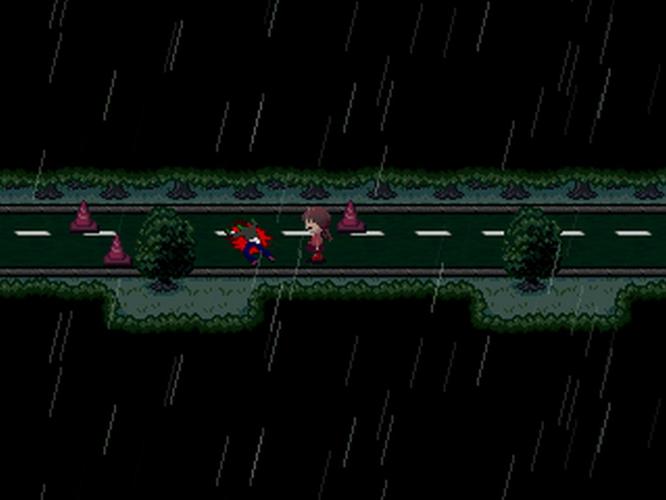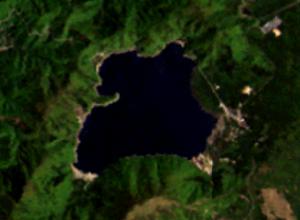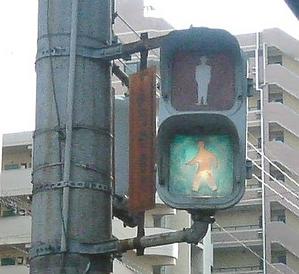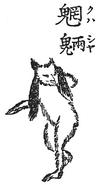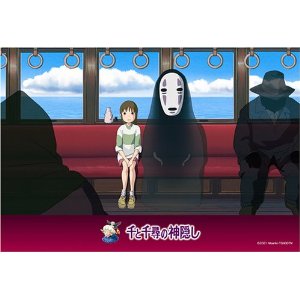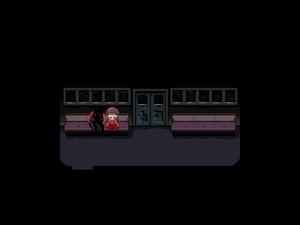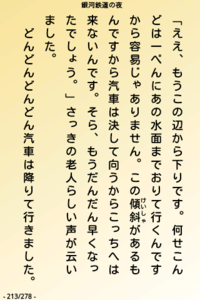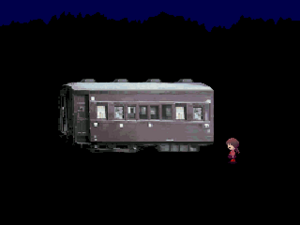>Mt.kiki No edit summary |
>Mt.kiki No edit summary |
||
| Line 61: | Line 61: | ||
[[File:ShitaiSan.png|thumb|Shitai-san]] | [[File:ShitaiSan.png|thumb|Shitai-san]] | ||
[http://en.wikipedia.org/wiki/Traffic_light#Types <u>2 Types</u>] [http://en.wikipedia.org/wiki/Traffic_light#Pedestrian_and_cyclist_crossing_lights <u>2.4 Pedestrian and cyclist crossing lights</u>] [http://en.wikipedia.org/wiki/Traffic_light#British_standard <u>2.4.4 British standard</u>] | [http://en.wikipedia.org/wiki/Traffic_light#Types <u>2 Types</u>] [http://en.wikipedia.org/wiki/Traffic_light#Pedestrian_and_cyclist_crossing_lights <u>2.4 Pedestrian and cyclist crossing lights</u>] [http://en.wikipedia.org/wiki/Traffic_light#British_standard <u>2.4.4 British standard</u>] | ||
| Line 72: | Line 70: | ||
:*Flashing green walking-man: Continue to cross if already in the intersection, but do not start to cross | :*Flashing green walking-man: Continue to cross if already in the intersection, but do not start to cross | ||
:*Red/Orange standing-man: Do not cross | :*Red/Orange standing-man: Do not cross | ||
[[File:Signal01.jpg|thumb|Shitai-san]] | |||
[http://ja.wikipedia.org/wiki/%E9%9D%92%E4%BF%A1%E5%8F%B7#.E3.81.9D.E3.81.AE.E4.BB.96 <u>12 その他</u>] | [http://ja.wikipedia.org/wiki/%E9%9D%92%E4%BF%A1%E5%8F%B7#.E3.81.9D.E3.81.AE.E4.BB.96 <u>12 その他</u>] | ||
※ "Blue jeans" originates in a Japanese "青信号(green/blue) light". | ※ "Blue jeans" originates in a Japanese "青信号(green/blue) light". | ||
日本では緑色表示を「緑信号」ではなく「'''[http://ja.wikipedia.org/wiki/%E9%9D%92 <u>青</u>]'''信号」と表現されている。 | 日本では緑色表示を「緑信号」ではなく「'''[http://ja.wikipedia.org/wiki/%E9%9D%92 <u>青</u>]'''信号」と表現されている。 | ||
In Japan, the green display is expressed as the "Blue signal" instead of a "Green signal." | In Japan, the green display is expressed as the "Blue signal" instead of a "Green signal." | ||
これは戦前、信号機が日本に初めて導入された際、マスメディアが「緑信号」を「青信号」と表現したことによるものである。 | これは戦前、信号機が日本に初めて導入された際、マスメディアが「緑信号」を「青信号」と表現したことによるものである。 | ||
Revision as of 08:18, 3 June 2013
The Dense Woods (樹海)
※Name of 「樹海」 is debug name that "Yumenikki Map File"
樹海(じゅかい)
Ocean of foliage
- It is a vast forest like the sea.Aoki-hara (ocean-of-foliage of the Mt.Fuji) is famous in Japan.
- Slang which points out the thing in a mountain or woods which commits suicide from Aoki-hara being made into the famous place of suicide.
※Relevance with "The Wood of the Self-Murderers: The Harpies and the Suicides" http://yumenikki.wikia.com/wiki/The_Dense_Woods(name)#The_Dense_Woods.28Kimajo.29
The Dense Woods (LSD (video game))
Developer(s) - OutSide Directors Company
Platform(s)PlayStation, PSN
『LSD (video game) 』 Release date(s) - JP October 22, 1998
http://en.wikipedia.org/wiki/LSD_(video_game)_
※Relevance with "Mt. Fuji of Yumenikki" of " Mt.Fuji of LSD (game)".
http://yumenikki.wikia.com/wiki/Number_World(name)#The_Stabbing_Room.28Mount_Fuji.29
Shitai-san (Traffic light)
※Shitai-san seems that a "Green Skin(Green walking-man?)", "Red blood(Red-Light?).
Shitai-san(Green Walking-man) became "Red Blood(Red-Light?)" and "Stopped life(Stopped signal?)"
2 Types 2.4 Pedestrian and cyclist crossing lights 2.4.4 British standard
British standard
In the United Kingdom, British Crown Dependencies and dependent territories, and former possessions like Hong Kong:
- Green walking-man: Cross with caution (pedestrians have the right of way; motorists turning left or right must yield to pedestrians
- Flashing green walking-man: Continue to cross if already in the intersection, but do not start to cross
- Red/Orange standing-man: Do not cross
※ "Blue jeans" originates in a Japanese "青信号(green/blue) light".
日本では緑色表示を「緑信号」ではなく「青信号」と表現されている。
In Japan, the green display is expressed as the "Blue signal" instead of a "Green signal."
これは戦前、信号機が日本に初めて導入された際、マスメディアが「緑信号」を「青信号」と表現したことによるものである。
This is because the mass media expressed the "Green signal" as the "Blue signal", when a signal is introduced into Japan for the first time prewar days.
Cat (Kasha (folklore))
※"Madotsuki(Cat)" is a "Kasha(burning chariot)" on the "Road"?
Kasha (火車?, lit. "burning chariot" or "burning barouche") is the name of a being from Japanese mythology, belonging to the higher range of demons, the Yōkai. The belief in Kashas is rooted in Shintoism and Buddhism.
1 Description
Japanese folklore describes the Kasha as humanoid cat-demons with the head of a cat or tiger and a burning tail. They are similar to other demons such as Nekomata and Bakeneko and get often interchanged with them.
※"Madotsuki(Cat)" is a "Kasha(humanoid cat-demons)",it is there is relation with a "dead person(Shitai-san)".
日本古来では猫は魔性の持ち主とされ、「猫を死人に近づけてはならない」「棺桶の上を猫が飛び越えると、棺桶の中の亡骸が起き上がる」といった伝承がある。
In Japanese ancient times, a cat is made into the owner of devilism and there is tradition of "not bringing a cat close to a dead person" and "the dead body in a coffin rising if a cat jumps over a coffin top."
また中世日本の説話物語集『宇治拾遺物語』では、獄卒(地獄で亡者を責める悪鬼)が燃え盛る火の車を引き、罪人の亡骸、もしくは生きている罪人を奪い去ることが語られている。
Moreover, by the collection "Uji shui monogatari" of tale tales of Japan, the car of the fire with which 獄卒 (悪鬼 which blames the dead in hell) burns vigorously is pulled, a sinner's dead body or a living sinner is taken, and last thing is told medieval times.
火車の伝承は、これらのような猫と死人に関する伝承、罪人を奪う火の車の伝承が組み合わさった結果、生まれたものとされる[1]。
The tradition of 火車 should be produced as a result of the tradition about these cats and dead persons and the tradition in straitened circumstances which takes a sinner combining [1].
※Possibly, he was killed in accident noting that the body would help the cat (the life was claimed by the cat)?
The Dense Woods(Art therapy)
※The "red corn" on the street has suggested the deadlock of life?
7 Art-based assessments 7.4 Road drawing
Road drawing
In this drawing assessment and therapeutic intervention, the patient is asked to draw a road. This is a projective assessment used to create a graphic representation of the person's "road of life." The road drawing has the potential to elicit spontaneous imagery that represents the client's origins, the history of his or her life process, experiences to date, and intent for the future - even from a single drawing (Hanes, 1995, 1997, 2008). The road's reparative features or its need for "periodic upgrade" can serve as a metaphor for the client's capacity for change and restoration (Hanes, 1995, 1997, 2008).
Traincar (Spirited Away)
※"Spirited Away" is no train of return.
釜爺の「間違えるなよ。昔は戻りの電車があったんだが、近頃は行きっぱなしだ」という台詞。
釜爺 "don't mistake.Although there was a train of return a long time ago, it only goes recently"
※"Night on the Galactic Rainroad" is no train of return.
銀河鉄道の夜(Night on the Galactic Rainroad)
「・・・この傾斜があるもんですから汽車は決して向うからこっちへは来ないんです。」
"... a train never comes here from the other side because of this inclination."
※It is not a steam locomotive(Galactic Train) but a train(Spirited Away's Train). http://yumenikki.wikia.com/wiki/Mars(name)#Final_Destination.28Night_on_the_Galactic_Railroad.29

